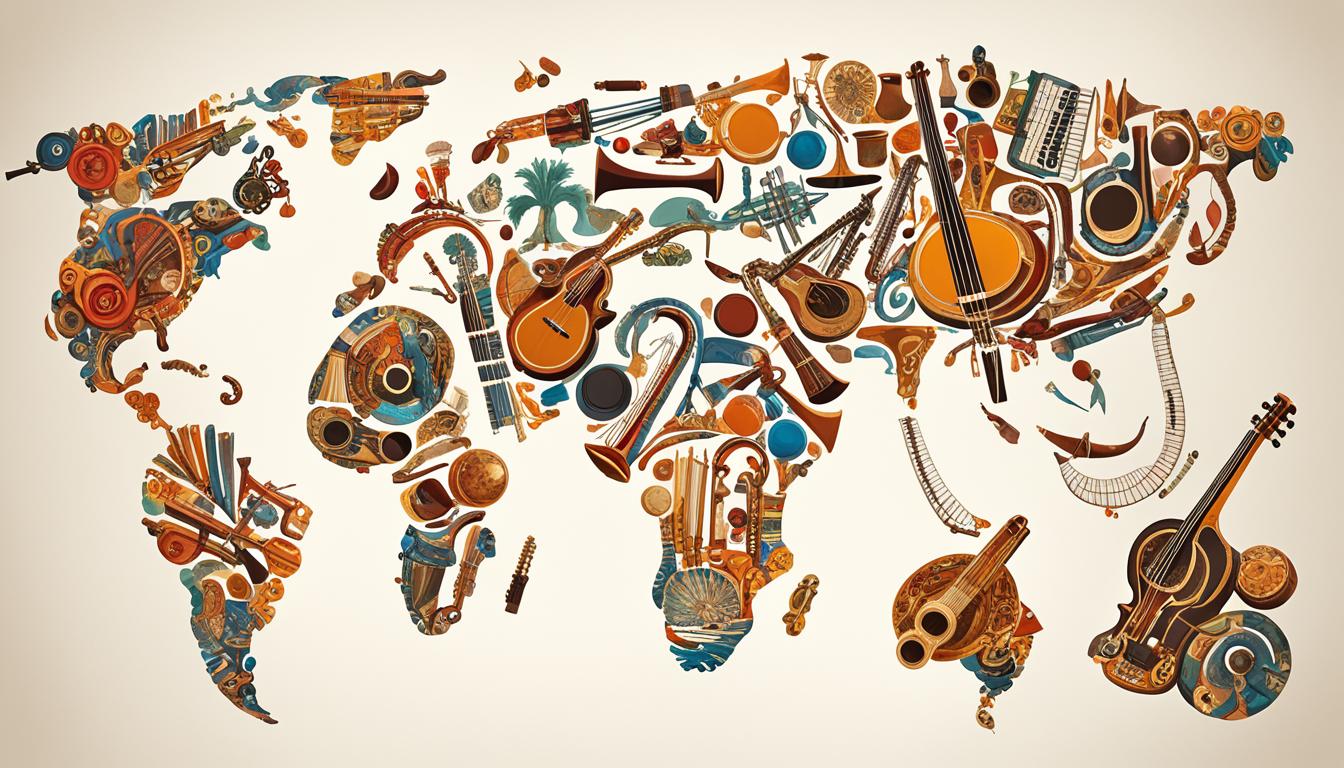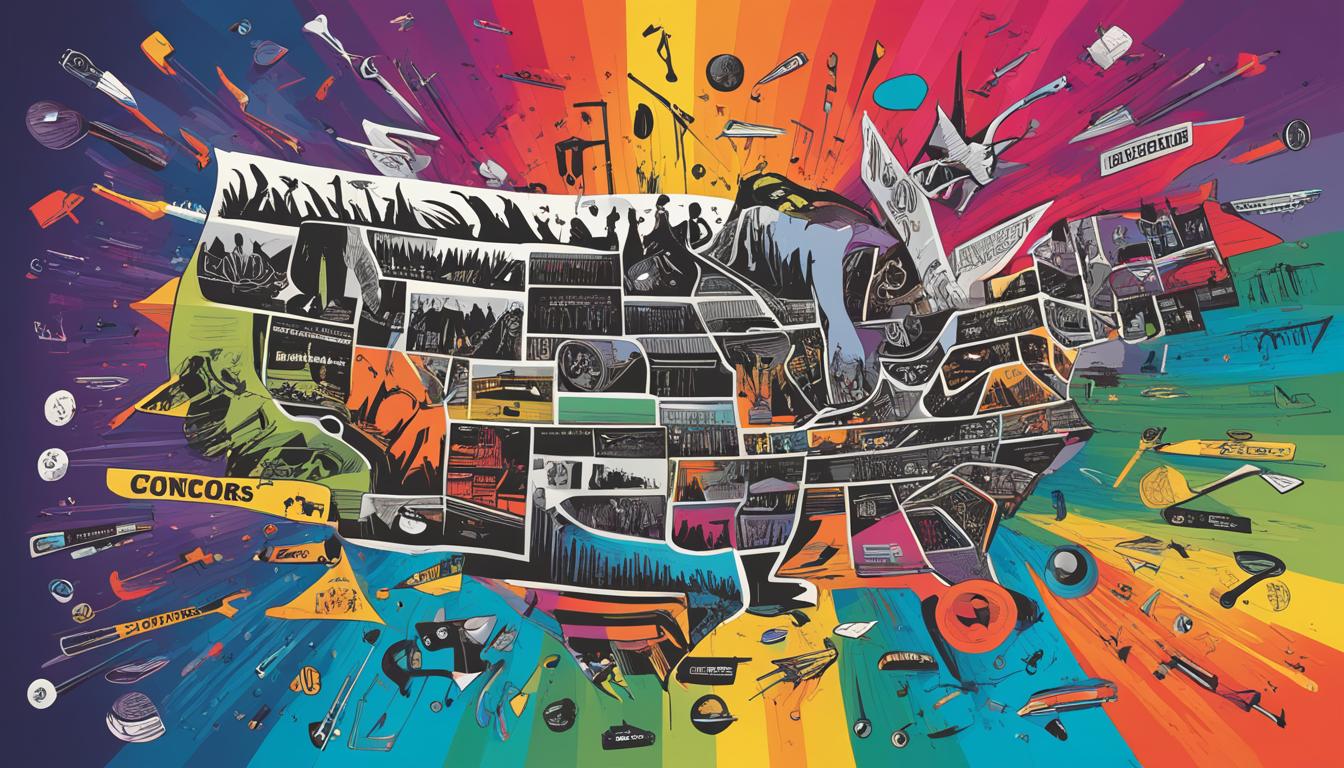Welcome to a captivating journey through the rich and diverse world of music genres and the legendary artists who have shaped them. From the soulful melodies of blues to the infectious beats of hip-hop, music genres have the power to evoke emotions, connect people, and shape cultures. In this article, we will dive deep into the vast spectrum of sounds and explore how artists have influenced and transformed popular music genres throughout history.
As music enthusiasts, we are constantly surrounded by a multitude of genres, each with its own unique characteristics and cultural significance. From the classical masterpieces of Mozart and Beethoven to the revolutionary rhythms of Elvis Presley and The Beatles, the evolution of music genres mirrors the evolution of our society and the human experiences we cherish.
By examining the different layers of music genres, we will gain a deeper understanding of how they are classified and how they have evolved over time. We will explore famous music genres from various eras, as well as contemporary music genres that have emerged in recent years, pushing boundaries and redefining what we know as popular music.
Key Takeaways:
- Music genres are diverse and encompass a wide range of sounds and styles.
- Legendary artists have played a crucial role in shaping and defining music genres.
- Contemporary music genres continue to evolve and push boundaries.
- The symbiotic relationship between music genres and artists fuels innovation and creativity.
- Music genres have the power to transcend cultural barriers and connect people globally.
Defining the Different Layers of Music Genres
In the vast world of music, genres serve as essential categories that define and classify the diverse range of sounds. Understanding the layers and classifications of music genres is crucial for appreciating their distinct characteristics and the artists who create them. Let’s explore the different layers that comprise the fabric of music genres.
Music Genre Classification
Music genres can be broadly classified into various categories based on their defining characteristics. These classifications can include factors such as rhythm, instrumentation, vocal style, and cultural influences. The classification of music genres provides a framework for understanding and categorizing the immense catalog of musical styles available.
Famous Music Genres
Over the course of history, certain music genres have emerged as iconic and influential, leaving a lasting impact on the music landscape. From the soulful melodies of blues to the rebellious energy of rock ‘n’ roll, famous music genres have shaped the evolution of music and inspired countless artists. Exploring these genres allows us to appreciate their historical significance and the artists who pioneered them.
Contemporary Music Genres
The world of music is constantly evolving, with contemporary music genres continually emerging and pushing the boundaries of creativity. These genres encompass a wide range of styles, from the infectious rhythms of pop music to the experimental sounds of electronic genres. Exploring contemporary music genres provides insight into the current trends and innovations in the ever-changing music industry.
Musical Icons: The Artists Who Shaped Genres
In the vast world of music, there are certain artists who have left an indelible mark on their genres. These iconic figures have not only created timeless music but have also shaped the direction and evolution of entire genres. From the pioneers of rock ‘n’ roll to the trailblazers of hip-hop, these famous music artists have pushed boundaries and redefined what is possible within their respective genres.
Throughout the ages, there have been legendary music artists who have captured the hearts and minds of listeners. Their contributions to the music industry have been celebrated and revered, making them household names and cementing their place in history. From Elvis Presley and The Beatles to Michael Jackson and Madonna, these artists have become cultural icons, inspiring generations of musicians and fans alike.
The impact of top music artists on their genres cannot be overstated. They have not only been trendsetters but have also challenged conventional norms, taking their genres to new heights. Artists like Bob Dylan and Bob Marley used their music as a platform for social and political commentary, inspiring change and influencing a whole generation.
Contemporary music genres have also seen the rise of influential artists who have pushed the boundaries of what is considered mainstream. Artists like Beyoncé, Kanye West, and Taylor Swift have not only dominated the charts but have also infused their genres with innovation and experimentation, blurring the lines between different musical styles.
These famous music artists have not only entertained us but have shaped the cultural landscape and touched our souls with their music. As we continue to explore the diverse world of music genres, it is important to recognize and celebrate the artists who have made an indelible impact on their respective genres.
From Folk to Electronic: A Music Genre List Journey
Embark on a captivating musical journey as we explore the vast landscape of music genres, from the roots of folk to the electrifying beats of electronic music. Each genre represents a unique blend of sounds, styles, and influences, contributing to the rich tapestry of contemporary music genres.
At the start of our journey, we encounter folk music, characterized by its heartfelt storytelling, acoustic instruments, and close connection to cultural traditions. Artists like Bob Dylan, Joan Baez, and Joni Mitchell have immortalized the folk genre with their poetic lyrics and soul-stirring melodies.
As we progress, we venture into the realm of rock music, bridging the gap between rebelliousness and artistic expression. From the raw energy of bands like Led Zeppelin and The Rolling Stones to the introspective musings of artists like David Bowie and Pink Floyd, rock music has continuously pushed boundaries and redefined itself over the years.
Next, we delve into the rhythmic beats of jazz, the genre of improvisation and innovation. Pioneers like Louis Armstrong, Ella Fitzgerald, and Miles Davis have mesmerized audiences with their virtuosity and ability to create musical magic in the moment. Jazz continues to evolve, fusing with other genres and giving birth to sub-genres like fusion, smooth jazz, and acid jazz.
Amping up the tempo, we arrive at the pulsating sounds of disco and dance music. This genre, characterized by its infectious grooves and energetic rhythms, has dominated clubs and dance floors worldwide. Artists like Donna Summer, Bee Gees, and Nile Rodgers have left an indelible mark on the disco era with their unforgettable hits.
The journey continues into the world of hip hop, a genre born from the streets and fueled by lyrical prowess and social commentary. From its early pioneers like Grandmaster Flash and Run-D.M.C. to modern icons like Jay-Z and Kendrick Lamar, hip hop has become a global phenomenon, empowering voices and inspiring change.
Moving forward, we encounter the melodic harmonies of pop music, a genre known for its catchy hooks and widespread appeal. Artists like Madonna, Michael Jackson, and Taylor Swift have dominated the pop charts, shaping the musical landscape with their infectious tunes and captivating performances.
Our journey reaches its climax with the pulsating beats and futuristic sounds of electronic music. From the revolutionary works of Kraftwerk to the genre-defying creations of Daft Punk and Skrillex, electronic music pushes the boundaries of what is musically possible, transporting listeners to new sonic dimensions.
As we conclude our genre exploration, we are reminded of the incredible diversity of sounds and styles that exist within the world of music. Whether you find solace in the introspective melodies of folk or lose yourself in the pulsating energy of electronic music, the music genre list journey is a testament to the boundless creative spirit of artists throughout history.
Music Genres and Artists: A Symbiotic Relationship
In the world of music, genres and artists share a symbiotic relationship, influencing and shaping each other’s evolution. Artists play a vital role in transforming genres, pushing boundaries, and creating new sonic experiences. Through their unique visions and artistic expressions, they breathe life into music genres, taking them in unexpected directions.
The Evolution of Sound: How Artists Transform Genres
Music artists hold the power to shape the trajectory of genres by infusing their own creative styles and influences. They take the existing elements of a genre and mold them into something entirely new, creating sub-genres and fusing different musical influences. From blending classical and rock elements to infusing hip-hop rhythms with electronic beats, artists continuously experiment and challenge the boundaries of genres.
Through their musical journeys, artists inspire and influence other musicians, expanding the possibilities of what a genre can be. They introduce unique sounds, unconventional instruments, and innovative production techniques, creating a rich tapestry of musical exploration.
Legendary Collaborations and Their Outcomes
In the collaborative world of music, artists from different genres come together to create magic. Legendary collaborations have the power to transcend genre boundaries, creating groundbreaking pieces of art that captivate listeners across different musical preferences. These collaborations blend the strengths of individual artists, resulting in fresh and exciting soundscapes.
When artists join forces from diverse genres, the outcomes can be astonishing. From unexpected mashups to genre-blurring masterpieces, these collaborations challenge traditional genre classifications and defy expectations. Through these creative partnerships, artists spark inspiration in one another, opening doors to new possibilities in genre fusion.
These collaborations not only push the boundaries of the artists involved but also influence the direction of entire genres. They introduce new sounds, expand the sonic palette, and inspire future generations of musicians to explore uncharted territories. The impact of these collaborations can be seen in the continuous evolution of music genres.
As the symbiotic relationship between music genres and artists continues to thrive, the landscape of contemporary music remains vibrant and ever-changing. Artists will continue to break barriers, redefine genres, and inspire listeners with their transformative and genre-bending creations. We eagerly await the next wave of innovation and collaboration, as the world of music evolves into new and uncharted territories.
Revolutionizing Sound: The Albums That Defined Music History
Throughout history, there have been albums that have revolutionized the music industry, pushing boundaries and leaving an indelible mark on the cultural landscape. These albums not only showcase the immense talent of the artists behind them but also redefine genres, captivate audiences, and stand the test of time. In this section, we will explore some of the top music albums of all time and delve into how they have crossed genre boundaries, influencing multiple genres and artists.
Top Music Albums of All Time
When it comes to identifying the top music albums of all time, the list is subjective and open to interpretation. However, certain albums have consistently appeared on numerous “greatest albums” lists and have had a profound impact on music history. These albums have resonated with audiences, both at the time of their release and for generations to come. They have become cultural touchstones, shaping the way we think about and experience music.
From Pink Floyd’s “The Dark Side of the Moon” to The Beatles’ “Sgt. Pepper’s Lonely Hearts Club Band,” these iconic albums have not only achieved critical acclaim but have also amassed immense commercial success. They have stood as works of art in their own right, pushing the boundaries of creativity and innovation in music production.
Albums That Crossed Genre Boundaries
Some albums have gone beyond the confines of a single genre, blending elements and styles to create groundbreaking and influential works. These albums have defied categorization, straddling multiple genres and appealing to a diverse range of listeners. As a result, they have not only gained recognition within their original genre but have also attracted fans from different musical backgrounds.
One such album is “Thriller” by Michael Jackson. Released in 1982, “Thriller” seamlessly combines pop, R&B, rock, and disco, creating a sonic experience that transcends traditional genre boundaries. The album’s groundbreaking music videos also revolutionized the music industry and solidified Michael Jackson’s status as the King of Pop.
Another notable album that crossed genre boundaries is “The Miseducation of Lauryn Hill” by Lauryn Hill. Released in 1998, this critically acclaimed album effortlessly melds elements of hip-hop, R&B, soul, and reggae, showcasing Lauryn Hill’s versatility as an artist. The album’s introspective lyrics and powerful vocals resonate with listeners across genres and continue to inspire artists to this day.
These albums that transcend genre boundaries highlight the transformative power of music and its ability to unite diverse audiences. They serve as reminders that creativity knows no limits and that true innovation often occurs when artists are unafraid to experiment and break free from convention.
In the next section, we will explore the global language of music and how genres break cultural barriers, bringing people together through the power of sound.
The Global Language of Music: How Genres Break Cultural Barriers
In the realm of music, genres have the extraordinary ability to transcend cultural barriers, uniting people from diverse backgrounds through a shared passion for rhythm, melody, and emotion. Popular music genres have achieved global recognition, captivating listeners worldwide and creating a universal language that knows no boundaries.
Contemporary music genres such as hip-hop, pop, rock, and electronic music have gained immense popularity on a global scale, capturing the hearts and ears of music enthusiasts across continents. These genres have become the soundtracks to our lives, crossing cultural divides and igniting a collective love for music.
Top music artists play a vital role in breaking down cultural barriers through their artistry. Their ability to skillfully blend different musical influences and draw inspiration from global music genres contributes to the creation of a cohesive and inclusive musical landscape.
Whether it’s Latin-infused beats in mainstream pop songs, African rhythms combined with electronic elements, or the incorporation of traditional instruments in contemporary compositions, global music genres continue to evolve and intertwine, resulting in a rich tapestry of cultural expression and musical innovation.
Artists like Beyoncé, Ed Sheeran, Drake, and BTS have made significant contributions to the global music scene, bridging gaps between cultures and demonstrating the universal power of music. Through their collaborations with artists from different corners of the world, they have created cross-cultural musical experiences that resonate with audiences globally.
Music has the remarkable ability to connect people on a level that transcends language and cultural differences. It speaks to the core of our emotions and effortlessly communicates messages of unity, love, and resilience. As the global language of music continues to thrive, it represents not only the harmonious blending of genres and cultures but also our shared humanity.

The Role of Independent and Underground Music in Genre Innovation
Independent and underground music scenes play a crucial role in driving genre innovation and shaping the contemporary music landscape. These scenes provide a platform for artists outside of the mainstream to explore new sounds, push boundaries, and experiment with unique musical expressions.
Unlike artists signed to major record labels, independent musicians have the freedom to create music that defies traditional genre conventions. They can blend different genres, incorporate unconventional elements, and challenge established norms, leading to the emergence of fresh and groundbreaking musical styles.
“The independent music scene has always been a breeding ground for genre-bending experimentation and artistic freedom. It allows musicians to follow their creative instincts without commercial pressures, resulting in some of the most innovative and influential music of our time.” – [Insert quote by famous independent artist here]
Moreover, the underground music scene provides a fertile ground for genre cross-pollination. Artists from various underground subcultures and niche music scenes often collaborate, share ideas, and merge their distinct musical influences, giving rise to hybrid genres that challenge categorization.
By embracing independent and underground music, listeners can discover a diverse range of sounds that might not be easily accessible through mainstream channels. This exposure to genre-bending and genre-defying music enhances our understanding and appreciation of different musical forms, paving the way for further genre innovation.
| Benefits of Independent and Underground Music |
|---|
| Encourages artistic experimentation |
| Fosters genre cross-pollination |
| Promotes diverse and unique musical expressions |
| Challenges mainstream genre conventions |
| Provides a platform for emerging artists |
Charting the Success: The Best Music Bands and Their Trajectories
In the dynamic landscape of the music industry, certain bands have managed to rise to the top, leaving an indelible mark on the collective consciousness of music lovers. These best music bands have not only achieved commercial success but have also influenced genres and shaped the direction of music as a whole. Let’s explore their extraordinary journeys from the underground to the mainstream.
From Underground to Mainstream: Band Journeys
The path to success for many iconic bands starts in the underground music scene. These bands often begin by performing in local venues, building a dedicated fanbase, and honing their craft. Through their relentless determination and undeniable talent, they gradually gain recognition and attract the attention of industry insiders.
As their popularity grows, opportunities arise for these bands to sign record deals, release albums, and embark on tours. Their music resonates with a broader audience, propelling them towards the mainstream. It is during this phase that their trajectories take an exciting turn, and their influence begins to extend beyond the boundaries of the underground scene.
Case Studies of Bands That Changed Music Tastes Globally
Several bands have transcended genres and had a profound impact on changing music tastes globally. These pioneers have pushed the boundaries of what is considered conventional, challenging listeners to broaden their musical horizons. Let’s delve into some noteworthy case studies:
The Beatles: This legendary British rock band revolutionized the music industry during the 1960s. Their innovative sound, infectious melodies, and charismatic personalities captured the hearts of millions worldwide. The Beatles paved the way for countless artists and set new standards for songwriting and production.
Nirvana: Led by the enigmatic Kurt Cobain, Nirvana burst onto the scene in the early ’90s, igniting the grunge movement. Their raw and authentic sound resonated with disenchanted youth, bringing alternative rock to the mainstream. Nirvana’s impact on music and popular culture can still be felt today.
Radiohead: Known for their experimental approach to music, Radiohead has continuously pushed the boundaries of alternative rock. With albums like “OK Computer” and “Kid A,” they challenged the conventions of the genre, exploring themes of alienation and technological dependence.
These bands, among many others, have shaped the musical landscape, inspiring future generations of musicians and leaving an enduring legacy.

Music bands hold a special place in the hearts of fans, with their journeys representing the pursuit of artistic excellence and the power of creative expression. These remarkable bands have not only reached the pinnacle of success but have also reshaped music in profound ways, forever ingrained in the annals of music history.
Conclusion
The exploration of music genres and artists has illustrated the vast and ever-expanding universe of sound that exists within the music industry. From classical to hip-hop, rock to electronic, the range of contemporary music genres is a testament to the limitless potential for innovation and creativity.
Throughout history, legendary artists have played a pivotal role in shaping and defining genres. Their influence has pushed boundaries, transformed sounds, and left a lasting impact on the musical landscape. By breaking cultural barriers and collaborating across genres, these artists have contributed to a global language of music that transcends borders.
As listeners, we find ourselves immersed in this auditory tapestry, witnessing the evolution of genres and the emergence of new sonic experiences. Our role as appreciators and enthusiasts allows us to appreciate the multitude of musical expressions and celebrate the diversity of voices within the industry.
FAQ
What are music genres and artists?
How are music genres classified?
What are some famous music genres?
What are contemporary music genres?
Who are some famous music artists throughout history?
What is the impact of top music artists on their genres?
What are some examples of music genres?
How do artists transform genres?
What are some legendary collaborations between artists from different genres?
What are some top music albums of all time?
How do music genres break cultural barriers?
How do independent and underground music scenes contribute to genre innovation?
How do bands transition from the underground scene to the mainstream?
What are some famous bands that have changed music tastes globally?
Source Links
- https://24hip-hop.com/cartier10x-unveils-a-genre-blending-hit-i-luv-it/
- https://news.fsu.edu/news/arts-humanities/2024/03/12/interlocking-art-a-multi-medium-gala-at-florida-state-university/
- https://rock95.com/canadian-rock-bands/



